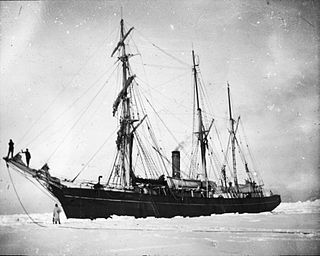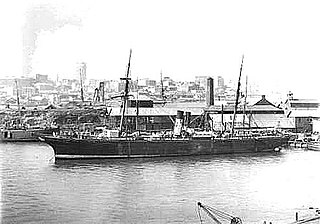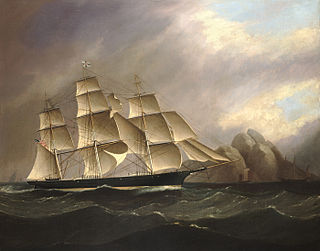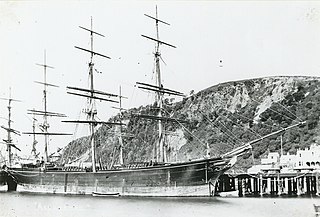
Nimrod was a wooden-hulled, three-masted sailing ship with auxiliary steam engine that was built in Scotland in 1867 as a whaler. She was the ship with which Ernest Shackleton made his Nimrod Expedition to Antarctica in 1908–09. After the expedition she returned to commercial service, and in 1919 she was wrecked in the North Sea with the loss of ten members of her crew.
The Wigham Richardson shipbuilding company was named after its founder, John Wigham Richardson (1837-1908), the son of Edward Richardson, a tanner from Newcastle upon Tyne, and Jane Wigham from Edinburgh.

Loch Ard was an iron-hulled clipper ship that was built in Scotland in 1873 and wrecked on the Shipwreck Coast of Victoria, Australia in 1878.

Lammermuir was an extreme clipper ship built in 1864 by Pile, Spence and Company of West Hartlepool for John "Jock" "White Hat" Willis & Son, London. She was the second ship to bear the name. The first Lammermuir had been the favorite ship of John Willis, and was wrecked in the Gaspar Strait in 1863.
SS Patroclus was a UK steam turbine passenger and refrigerated cargo liner launched in 1923. She was the third of five ships to bear the name.

City of Adelaide was an iron-hulled ship that was launched in Scotland in 1863, spent a long career in Australian passenger and cargo service, and sank off the coast of Queensland in 1916. She served with several Australian shipowners, including the Australasian Steam Navigation Company, Australasian United Steam Navigation Company and Howard Smith Company.

Ocean Telegraph was a clipper ship that was built in Massachusetts in 1854 and was last known of in Gibraltar in 1923. She was in US ownership until 1863, when UK interests bought her and renamed her Light Brigade.

Windsor Castle was a wooden-hulled, three-masted sailing ship that was built in England in 1857 and wrecked off the coast of Cape Colony in 1884.

MV Struma was a small ship with a long history that included a number of changes of use and many changes of name. She was built in 1867 as a British marquess's luxury steam yacht and ended up 75 years later as a Greek and Bulgarian diesel ship for carrying livestock. She was launched as Xantha, but subsequently carried the names Sölyst, Sea Maid, Kafireus, Esperos, Makedoniya and finally Struma.

SS Pericles was a UK steam ocean liner and refrigerated cargo ship. She was launched in 1907 in Ireland for the Aberdeen Line service between Great Britain and Australia via South Africa. When new, she was the largest ship on the route.

Allahabad was an iron-hulled full-rigged ship, built in Liverpool in 1864. She was later re-rigged as a barque and disappeared in 1886 on a voyage from Scotland to New Zealand.

The Murray was a three-masted clipper ship that was built in Scotland in 1861 and lost off the coast of Sweden in 1884. For nearly 20 years, the Orient Line sailed between London and South Australia. In 1880, Norwegian owners bought her and renamed her Freia.

Hesperus was an iron-hulled, three-masted, passenger clipper ship that was built in Scotland in 1874 and scrapped in Italy in 1923. She was built for Thompson and Anderson's Orient Line service between Great Britain and South Australia.

Yatala was a British clipper ship that was built in England in 1865 and wrecked on the north coast of France in 1872. She spent her seven-year career with Anderson, Thomson and Co's Orient Line, sailing between London and South Australia.

South Australian was a composite-hulled clipper ship that was built in Sunderland in 1868 and sank in the Bristol Channel in 1889. She was a successor to clippers St Vincent and City of Adelaide. For nearly two decades she voyaged annually between London and South Australia.

Coonatto, was a British three-masted clipper that was built in 1863 and wrecked in 1876. She traded between London and Adelaide for 12 years. She was wrecked in the English Channel in February 1876.

Orient was a wooden-hulled, three-masted sailing ship that was built in England in 1853 and scrapped in Gibraltar in 1925. She served in the Crimean War, and then spent two decades with James Thompson & Co's "Orient Line" of ships sailing between Great Britain and South Australia.
St Vincent was a three-masted sailing ship that was built in England in 1865, renamed Axel in 1894 and scrapped in 1907. For the first part of her career she was a clipper, trading between London and Adelaide. She was later re-rigged as a barque, and spent the final part of her career she was under Norwegian ownership.
Loch Sunart was an iron-hulled sailing ship that was built in Scotland in 1878 for Loch Line's service between Great Britain and Australia. The ship was named after Loch Sunart in Lochaber.















